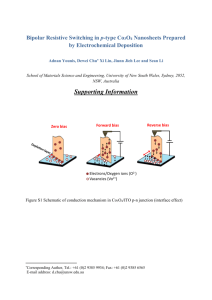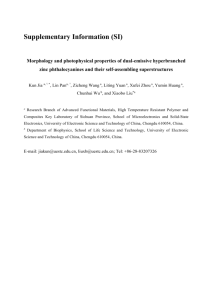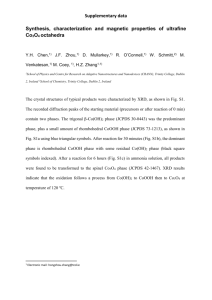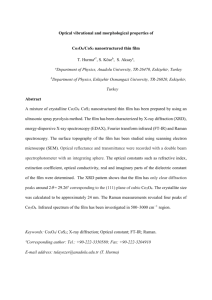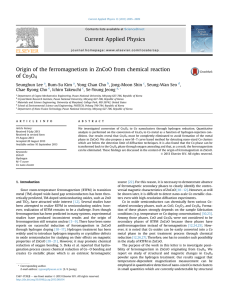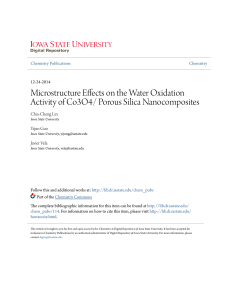volatile organic compound gas sensor based on meso
advertisement
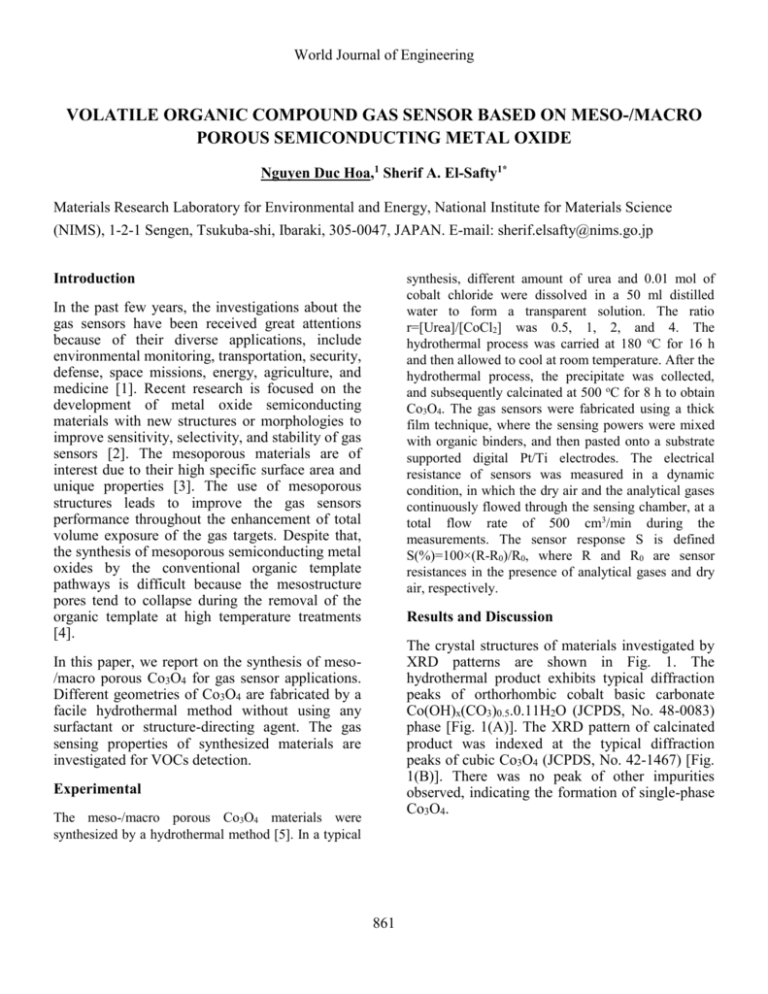
World Journal of Engineering VOLATILE ORGANIC COMPOUND GAS SENSOR BASED ON MESO-/MACRO POROUS SEMICONDUCTING METAL OXIDE Nguyen Duc Hoa,1 Sherif A. El-Safty1* Materials Research Laboratory for Environmental and Energy, National Institute for Materials Science (NIMS), 1-2-1 Sengen, Tsukuba-shi, Ibaraki, 305-0047, JAPAN. E-mail: sherif.elsafty@nims.go.jp Introduction synthesis, different amount of urea and 0.01 mol of cobalt chloride were dissolved in a 50 ml distilled water to form a transparent solution. The ratio r=[Urea]/[CoCl2] was 0.5, 1, 2, and 4. The hydrothermal process was carried at 180 oC for 16 h and then allowed to cool at room temperature. After the hydrothermal process, the precipitate was collected, and subsequently calcinated at 500 oC for 8 h to obtain Co3O4. The gas sensors were fabricated using a thick film technique, where the sensing powers were mixed with organic binders, and then pasted onto a substrate supported digital Pt/Ti electrodes. The electrical resistance of sensors was measured in a dynamic condition, in which the dry air and the analytical gases continuously flowed through the sensing chamber, at a total flow rate of 500 cm3/min during the measurements. The sensor response S is defined S(%)=100×(R-R0)/R0, where R and R0 are sensor resistances in the presence of analytical gases and dry air, respectively. In the past few years, the investigations about the gas sensors have been received great attentions because of their diverse applications, include environmental monitoring, transportation, security, defense, space missions, energy, agriculture, and medicine [1]. Recent research is focused on the development of metal oxide semiconducting materials with new structures or morphologies to improve sensitivity, selectivity, and stability of gas sensors [2]. The mesoporous materials are of interest due to their high specific surface area and unique properties [3]. The use of mesoporous structures leads to improve the gas sensors performance throughout the enhancement of total volume exposure of the gas targets. Despite that, the synthesis of mesoporous semiconducting metal oxides by the conventional organic template pathways is difficult because the mesostructure pores tend to collapse during the removal of the organic template at high temperature treatments [4]. Results and Discussion The crystal structures of materials investigated by XRD patterns are shown in Fig. 1. The hydrothermal product exhibits typical diffraction peaks of orthorhombic cobalt basic carbonate Co(OH)x(CO3)0.5.0.11H2O (JCPDS, No. 48-0083) phase [Fig. 1(A)]. The XRD pattern of calcinated product was indexed at the typical diffraction peaks of cubic Co3O4 (JCPDS, No. 42-1467) [Fig. 1(B)]. There was no peak of other impurities observed, indicating the formation of single-phase Co3O4. In this paper, we report on the synthesis of meso/macro porous Co3O4 for gas sensor applications. Different geometries of Co3O4 are fabricated by a facile hydrothermal method without using any surfactant or structure-directing agent. The gas sensing properties of synthesized materials are investigated for VOCs detection. Experimental The meso-/macro porous Co3O4 materials were synthesized by a hydrothermal method [5]. In a typical 861 World Journal of Engineering acetone, followed by ethanol and benzene. The sensor response was 1850%, 2236%, and 2664% for 74570, 149111, and 223666 ppm concentration of acetone, respectively. The linear dependence of sensor response as a function of acetone concentration in measured range is one of the advances in its practical application because of the easy design in the read-out signal circuit Fig. 1 XRD patterns of (A)- hydrothermal products, and (B)- after calcination. The effects of urea content on the morphologies of Co3O4 investigated by FE-SEM images are shown in Fig. 2 (A)-(D). At low ratio of r=0.5, the product contains nanoparticles with grain size of ~100 nm [Fig. 2(A)]. Increasing the r value to 1 or 2, the obtained products were porous nanorods in which the nanorods are generated from aggregated nanoparticles of average particles size is about 100 nm, as shown in Fig. 1 (B). The porous nanorods have an average diameter of about 250 nm, and a length up to micrometers. However, further increase the r value to 4, the porous plates were obtained instead of porous nanorods [Fig. 1(D)]. Fig. 3 (A) the dependence of sensor response on the [Urea]/[CoCl2] ratio, and (B) the response of porous Co3O4 nanorods as a function of gases concentration. Conclusion Different morphologies of porous Co3O4 materials have been successfully synthesized. The synthesized materials were found to be effective in the detection of acetone, benzene, and ethanol. It has good stability, high sensitivity, and fast response and recovery time. Acknowledgment This work was supported by the Japan Society for the Promotion of Science (JSPS), grant No. P09606. Fig. 2 FESEM images of Co3O4 synthesized with different r=[Urea]/[CoCl2] ratio: (A) r=0.5, (B) r=1, (C) r=2, and (D) r=4. References: 1. Sysoev, V. V., Goschnick, J., Schneider T., Strelcov, E., Kolmakov, A., Nano Lett., 7 (2007) 3182-3188. 2. Wang, Y. D., Djerdj, I., Antonietti, M., Smarsly, B., Small, 4 (2008) 4, 1656-1660. 3. (a) S. A. El-Safty, et al. Phys. Chem. C, 112 (2008) 4825-4835; (b) S. A. El-Safty, T. Hanaoka, Adv. Mater. 15 (2003) 1893-1899; (c) S.A. El-Safty, T. Hanaoka and F. Mizukami, Adv. Mater. 17 (2005) 47. 4. Li, L., Krissanasaeranee, M., Pattinson, S. W., Stefik, M., Wiesner, U., Steiner, U., Eder, D., Chem. Commun., 46 (2010) 7620-7622. 5. Nguyen, H., El-Safty, S. A., J. Phys. Chem. C, 115 (2011) 8466-8474. The gas sensing properties of materials synthesized with different [Urea]/[CoCl2] ratio were investigated for benzene, as shown in Fig. 3(A). It is clearly that the material synthesized at [Urea]/[CoCl2] ratio of r=2 showed the highest response. This mean that the nanorods based sensor has the highest response. The sensing properties of porous nanorods were further investigated for detection of acetone, benzene, and ethanol [Fig. 3(B)]. Sensor response is highest for 862 World Journal of Engineering 861
